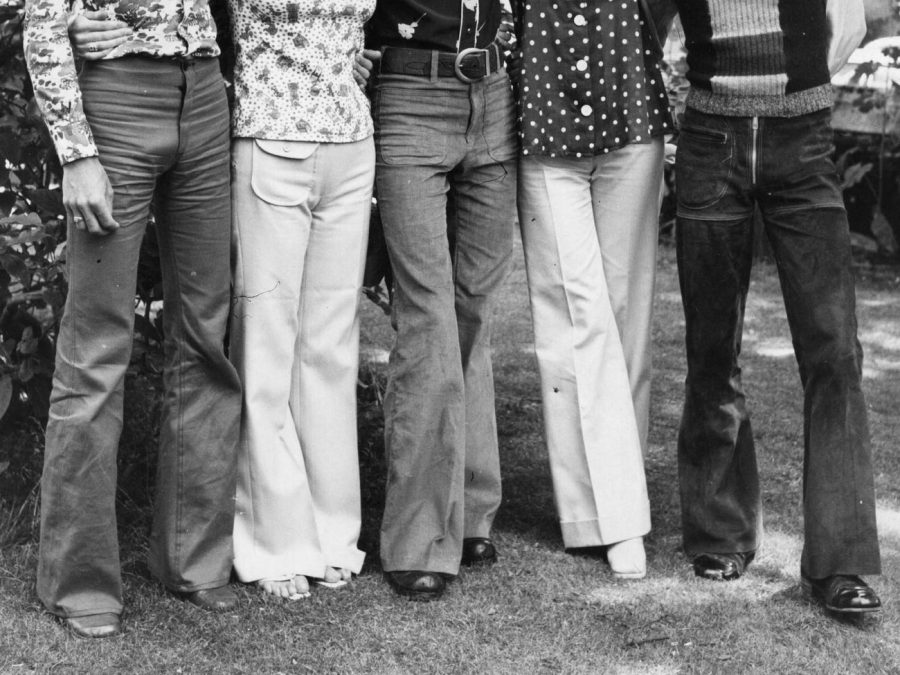Decades in Denim
The American Jean
As the weft threads pedantically pass over and under innumerable warp fibers, an intricate cloth, warmly celebrated as denim, takes its beloved form. Denim, unlike many other pant counterparts, transcends socioeconomic status, gender barriers, and constraining societal pressures. The twill weave, or rather, denim’s genes (see what I did there) has been crafted such that it forms a signature stitch on the reverse side of the fabric, and by using different colors, each jean displays a different, unique hue. The origin of this special fabric is often discussed, yet there is no definite answer to the controversial question. Our best guess pits two countries against one another, as some say the fabric was born in the town of Nimes, France while others argue it is yet another Italian delicacy. Wherever its birthplace may be, this fabric has certainly not limited its material worth to just one country, or continent. And while its global reach is certainly fact, not fiction, the ideas put forth will be concerning denim in America and its role in fostering the American dream.
Early in 1789, a Rhode Island newspaper was the first to produce the word “denim” in print. Seventy-five years later, in 1864, denim was defined in Webster’s dictionary as “a coarse cotton drilling used for overalls, etc”. What caused denim to become a household name? The answer can actually be traced back to the gold mining boom of the 1800s, which caused workers to rapidly go through pieces of clothing. Thus, it was time for a now well-known favorite to come in and save the day: Levi’s, founded in the 1800s by German immigrant, Levi Strauss. Originally made of canvas, Strauss eventually switched to making jeans from denim to provide the breathability that workers lacked in previous pants. Coupled with a Nevada tailor, Jacob Davis, rivets and a global admiration for Levi’s was secured.
Jeans first started becoming commonplace in the 1930s, when blue jeans stepped onto the big screen and made their Hollywood debut on the classic American cowboys. In the 1940s, our country faced loss, both in lives and clothing sales, yet it was also at this time that jeans gained popularity amongst the hearts of foreigners. American soldiers can be best accredited for this new global trend, seeing as jeans were a popular “off-duty pant”. After the war, our favorite rebel, actor James Dean, was the ideal person to carry denim into a new, rebellious phase in the 50s. Thousands flocked to denim as a way to express themselves, finally set free from constricting fashion barriers during the war. This new hunger for denim inspired several other brands to join the race for the public eye.
The 60s breathed new life into denim, with styles such as embroidery and psychedelic prints mirroring the fall of social taboos. In the 70s, the flare leg pant soon rose to popularity. And then came the 1980s, where several heavy hitters joined the denim competition, namely: Gucci, Guess, and Versace With these additions, denim found its way into the luxury market and cast aside its previous rebellious front. The carefree flare pants of the 70s were tightened, and punk-inspired skinny jeans graced the decade. Following in true punk suit, jeans were bathed in new colors such as acid wash and heavier blacks, fueled by the public’s desire to replicate the look of Joey Ramone, whose voice graced our records.
However, the rebellious denim of the 50s did return, but in a new form. In the 1990s, angsty teens were fueled by the disdain they held for their parents and their conservative outfits, so much so that they widened their horizons, and seemingly, their pant legs. Slouchy jeans and flannels, commonly known as “grunge,” became the rage of the time, marked by several key players. Another key aspect of “1990s jeans” was the unforgettable rips. While I am personally not a fan of large rips, I am certainly in the minority there, as rappers and a variety of individuals took to destroying the cloth of which jeans are made, as a way of expressing themselves.
The 1990s were also marked with several key figures. Princess Diana favorably wore jeans throughout her life, further exemplifying jeans blurring the lines between “high class” and what the public thought to be “low class” fashion. Towards the end of the 20th century, the love for Levi’s was finally usurped, with Calvin Klein emerging as a key player in the history of the beloved jean.
In the early 2000s, naughty (or “y2k” as they are known now) jeans made their way onto the red carpet. And, though jeans were back on the rise, waistlines were on the decline, with the top of the jean barely reaching above the hip bone. The contributors of such a change in denim are widely spread, yet, 7ForallMankind, True Religion, and Diesel splashed our screens and initiated the growth of low-rise jeans on the controversially bare bodies of many young celebrities. However, one cannot dispute that our generation does not have, or rather display, the same amount of adoration that was once held about denim – perhaps yet another horrible product of athleisure, or, more recently, the rise of leather pants. Whatever the reason may be, it is important to remember that jeans have marked each decade in a different way, and not for lack of other clothing options. What was once a worker’s overalls can now be appropriately styled with a blazer for an interview or with a sweater when going out to a nice dinner; these pants have debunked the once “uncrossable” lines between so many demographics, whether that be gender, age, or economic status.
While brands such as Agolde are painting jeans with a very hefty price tag, it is important to note that jeans, perhaps more than any other clothing item, are best found thrifted. Thrifting is most certainly a difficult task, yet, with some help from a knowledgeable source (otherwise known as your favorite fashion editor), not entirely out of the question. First, you must assess your body: height, shape, etc, to best see what will compliment your frame. For shorter figures, I always prefer slightly flared-out jeans, one which inherently continues the line of your leg. For taller fashionistas, there is more room to play with stripes alongside the side of your jeans, or baggy jeans if you are trying to draw attention away from those extra inches. The next step when finding the perfect pair of jeans is all about the details: the seam, button, pocket location, and style, or in other words, those little details you tend to skip over. Yet, while you may look them over when shopping, they are surprisingly noticeable to passersby. Embellishments, rips, colors, and patterns are the final step in choosing the perfect jean for you, one that depicts your personality through denim.
Thrifting is a universal win with jeans, which is understandable because these fan-favorite pants have just a little bit of history to them. Always remember, keep walking and your jeans will take you where you want to go. With that being said, stay tuned and stay you.

Nora, an IB Senior, is thrilled to take on the role as Features Editor within the Harriton Banner. When not editing, Nora is the President of DECA, an...


